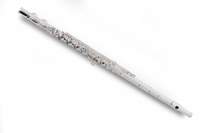Announcement,
Choosing a new flute: Open Hole vs Closed Hole
The choice between playing on an open or closed hole flute is a preference, but as a flautist begins to advance, an open hole model becomes a more serious consideration when the time comes to upgrade from their student model. So, what is the difference and why might you choose one over the other?
Closed Hole
On a closed hole, or ‘plateau’ flute, all the keys that you press are fully covered with metal and a pad that closes the hole. It is usually recommended that beginners start with a closed-hole instrument as this is easier than having to worry about the accuracy of hand and finger position that is needed in order to play an open-hole model. Closed keys are also easier for younger players or those with smaller hands who may not have the reach to cover open holes properly. Although closed holes are standard for student models, they can be found on professional models too.
Open Hole
As your playing progresses, your teacher may suggest a move to an open hole or ‘ring key’ model, also sometimes referred to as a French open hole flute. This means that five of the keys (2 on the left hand and 3 on the right hand) have a hole in the centre which need to be completely covered with the player’s fingers in order to produce a sound. The holes can be closed with a plug to begin with and removed over a period of time as you become accustomed to using open holes.
Why choose an open-hole flute?
There are a few reasons why you may choose to progress to an open-hole flute.
Tone
It is sometimes argued that open-hole flutes produce a ‘better’ sound. However, this is attributable to the fact that open holes are usually a feature of more advanced instruments, produced with higher-quality materials that will enhance a player’s tone in any case.
Improved posture
For advancing flautists, open holes encourage a better hand position which will also improve playing posture. Good hand position will naturally improve movement, resulting in a faster and more fluid finger technique.
Extended techniques
Extended techniques are a way of extending the flute sound beyond that which you would traditionally hear. An open-hole flute facilitates sound effects such as glissandos, multiphonics or quarter tones, for example. Composers including Ian Clarke, Robert Dick and Robert Aitken amongst many others have included extended techniques in their works, so if you want to be flexible with the repertoire you play to include contemporary flute pieces, an open-hole flute will be necessary.
So, which do I choose?
The pros and cons of playing an open or closed-hole instrument have long been debated amongst flautists. World-renowned and respected flautist Marcel Moyse proclaimed that closed-hole flutes were superior, but the techniques and works for open-hole flutes at that time had not yet been developed. However, contemporary pro-open hole flautist and composer Robert Dick feels that playing on a closed hole model restricts a player’s ability to exploit the full range of the flute’s beauty.
Essentially, the choice between open or closed holes is really a personal one, but the type of repertoire you want to focus on may influence your decision.
If you really only want to play music from the Baroque or Classical eras, you may want to stick with a closed-hole instrument, and there are certainly some very good closed-hole instruments in the intermediate and professional range. However, an open-hole flute should be a serious consideration for players looking to upgrade their instrument. Holes can be plugged, and the plugs removed over time as you get used to using an open-hole model. This will mean that you have much greater flexibility in the future with the repertoire you choose to play. Indeed, some performers keep holes plugged, removing them for pieces that require the performance of extended techniques, thus offering the best of both worlds.
This is well regarded as an excellent value flute which features open holes and is solid silver throughout. This makes an ideal upgrade instrument for the advancing player and the solid silver construction adds fantastic projection to the tone.
The Pearl 695RE 'Dolce' series flute is an excellent intermediate level, silver plated instrument with the added benefit of a solid silver 'Forza' headjoint, enabling players to create a full-bodied and resonant sound.




